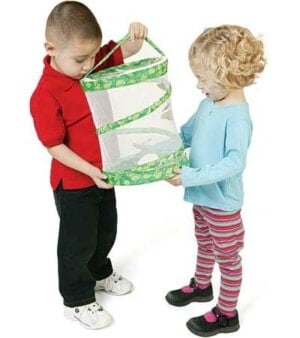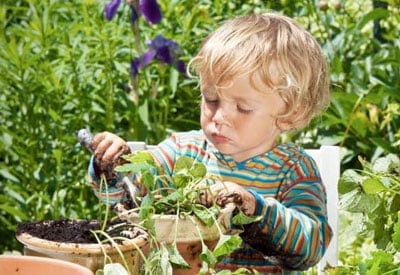Children love to play in the dirt. They like to search for earthworms and bugs. They like to create things. They like destroying things just as much. Watering plants, and anything else, brings great joy. Our little ones want to be part of the household and do some of the same things as mom and dad. Why not involve them in the garden?
Gardening with kids can be anything from planting seeds inside on a windowsill to caring for houseplants, to helping design and maintain a full-fledged garden. Big or small, growing projects teach kids to nurture seeds and plants — and thus themselves — and responsibility. They gain self-esteem and a deeper connection to the natural world. By prepping soil, sowing seeds and watching seedlings sprout, kids get important lessons in science and the environment without even knowing it. They might even want to eat the vegetables they tended to.

FREE SHIPPING
Praying Mantis
Shipped as egg cases, praying mantis require several weeks of warm temps to hatch.
Learn morePlanet Natural is here to help you create a successful and memorable growing season with your young ones with just the right gardening tools and equipment to get the whole family involved!
Creating a Garden
Getting young ones involved in the garden design process gives them a sense of ownership. Depending on the age of the child they may simply be playing in the garden or maintaining their plot pretty much on their own.
Give children as much leeway as possible, depending on their age and maturity. Older kids can create a budget for the garden (based on an amount of money you’ve decided on) and plan when and where to plant what. Younger children will be happy picking one or two plants to add to the family garden.
Preparing the Soil
Now’s the time to talk to your child about what makes a good garden spot. Look for a place with plenty of sun and easy access to water. If you don’t have great soil already — and most of us don’t — you’ll need to do a little amending before planting (see our article on Building Garden Soil here).
Some children will love digging (tilling) the soil and adding compost. During the “dirt party” they can look for earthworms (a good indicator of healthy soil) or other bugs. Explain how plants need food and water — just like we do — and that healthy soil will provide that for them.
Sowing Seeds
If you decide to grow your own seeds indoors, get started about 6-8 weeks before you plan to move them out to the garden.
Purchase plastic starting trays or create your own containers out of waxed lined milk cartons, yogurt cups, or anything else you can find around the house that will hold water. Then, poke drainage holes in the bottom.
Fill the pots with a damp organic starter mix (not soil) to within 1/4-inch of the top and level the surface. After adding the potting mix, place small seeds on top of the mix and push larger seeds into it. Make sure to label each container, so you remember what’s growing in them.

POTS YOU PLANT
Pot Maker
Create your own 2 in. biodegradable plant starters out of recycled newspaper.
$19.95Learn moreJust say NO to plastic! The Pot Maker recycles old newspaper into ideal starter pots for young transplants and seedlings. Easy to use, just roll and press — no glue required! When plants are large enough, plant pot and all into the garden.
Water and cover the containers with plastic. This will help keep humidity levels up and moisture levels constant.
Place the pots somewhere where they will get full sun most of the day. Most people will need to purchase some type of grow light to supplement the weak sunlight our houses tend to get, especially in the early spring. Learn more about indoor plant lighting here.
When the seeds sprout into seedlings, remove the plastic to prevent plant diseases and continue to keep the soil moist.
Choosing Plants
Choose seeds that mature quickly and provide a quick reward. It can be frustrating for kids to sow seeds and then have to wait weeks to see the plant. Broccoli, carrots, lettuce, peas, potatoes, radishes and zucchini are good vegetable choices.
Children like extremes such as huge sunflowers and tiny cherry tomatoes. Or pick things they know in colors they won’t expect, such as purple carrots, rainbow chard or striped beets. Click on Gardening Fun for Kids for a list of several other garden favorites that are available in unusual colors or sizes.
Most importantly, let kids have a say in what grows in the garden. They’ll love picking out seed packets or starter plants. Discuss how to choose plants that are most likely to survive and thrive in your neck of the woods.

Theme Gardens
Your child’s garden doesn’t need to be in straight rows and only contain vegetables. If a love of gardening is what you are trying to instill, try a fun theme garden.
Growing a sunflower house for your kids makes a great hideout or quiet place to read a book.
Surprise your little gardener by planting a quick growing plant, such as radishes or clover, in the shape of his or her initials or name.
A party garden, full of popcorn, peanuts and watermelon will be as fun to grow as it is to eat.
If your child is lured in by the strange and weird, plant an odd behavior garden. These plants will curl up, spew seeds and even produce a mini-fireball.

READY TO GROW!
Mushroom Garden
Easy. Fun. Delicious. Produces 1.5 lbs of gourmet oyster mushrooms in two weeks!
$24.95Learn moreEasy. Fun. Delicious. The Back to the Roots® Mushroom Garden produces a pound and a half of gourmet oyster mushrooms in under two weeks! Recycled coffee grounds act as the soil; just mist twice per day (mister included) and get ready to harvest.
Animal lovers might enjoy planting catnip for the family kitty, or flowers that attract butterflies (see How to Make Butterfly Gardens). Rabbit lettuce (Lactuca sativa) is the perfect crop for the owner of a bunny and an earthworm farm is fun to play with and provides nutrient rich worm castings.
Container Gardens
You can garden with your kids even if you don’t have a lot of room. Planting in pots let kids have fun, create masterpieces and are small enough to easily manage.
Let your kids pick funky containers (dump truck toys they don’t play with anymore, odd colored urns from the thrift store) and drill a few holes in the bottom. Fill with an organic potting medium — not soil — and water well.
Then add a few plants of your child’s choosing. Encourage them to choose plants that will grow well in your climate. They might like brightly colored flowers or yummy vegetables. Don’t worry if they pick plants that you normally wouldn’t grow together — this is their place to experiment.
Indoor Projects
There is no need to wait until spring to start planting. Indoor projects allow children to garden all year. They provide great winter activities as well as spots of nature for those who don’t have room to grow outside.
See the section above (Sowing Seeds) for getting seeds started inside. These plants can be moved outside to a garden or simply transplanted to a larger pot and kept in the house.
Terrariums are a collection of plants grown inside a glass or plastic container. They have an otherworldly feeling and are fun for kids. Find an old fish bowl, jar or other clear container, partially fill with organic, well-draining potting material and add plants. You’ll want low growing, dense plants. Place the whole thing as near as possible to direct light and water as needed.
Grow your own potatoes, carrots or avocados. For potatoes, find an old one that has sprouted. Cut the sprout, plus a few inches of potato surrounding it and poke a few toothpicks into it to support it over a glass of water. Place the cut side down (the water should be touching the potato) and put it in a sunny window. Keep the water level high and soon you’ll see potato vines.

LIVE BUTTERFLIES!
Butterfly Kit
After raising your butterflies, experience the joy of releasing them into your backyard!
$24.95Learn moreWatch them grow then let them go! Raise butterflies while learning all about metamorphosis with the award-winning Insect Lore® Live Butterfly Garden! See each caterpillar’s transition as it matures, changes into a chrysalid, and finally emerges as a Painted Lady butterfly!
Try the same thing with carrot tops, as long as the carrot is still green in the middle. Avocado seeds can also be grown the same way (see Start an Avocado from Seed). Be sure the bottom of the seed is always in the water. Your kids will need a little patience with this one as it takes several weeks or even a month for the seed to sprout. After leaves and roots appear, plant the seed in a small pot of soil, keeping the top of the seed a little above the surface of the soil.
Kids will enjoy growing eggshell people with funny hair, tending to a windowsill herb garden or feeding insects to carnivorous plants.
Reading gardening-related children’s books can inspire kids during the winter dull doldrums or give them ideas for their own gardens.
Tips
Invest in some kid-sized gardening tools. Tools made for adults are too big for little hands and can be frustrating to use. Be sure to get well made tools as cheap, plastic ones usually don’t work very well and will break easily. Or raid your kitchen for heavy spoons and measuring cups to be used as scoops.
Grow organically. Your little ones will have their hands all over the plants and dirt. And what starts out on their hands ends up in the mouths, eyes and noses. Avoiding synthetic fertilizers and pesticides will not only be healthier for the garden and the environment, it will be much better for your kids. Visit the Organic Gardening Guru to learn all there is to know about growing organically.
When giving your child their own garden, start small. Use a yardstick to measure off a manageable plot of land. You can always enlarge their space the following year, or even during the growing season.
Create a garden chart to hang in the house. Kids can cross off (or get a gold star for) every task they complete — from sowing seeds to watering to weeding.
Know that you will probably being doing a lot of the work, especially the more monotonous chores like daily watering and weeding. Make the garden a place you want to be in and a size you can enjoy.











